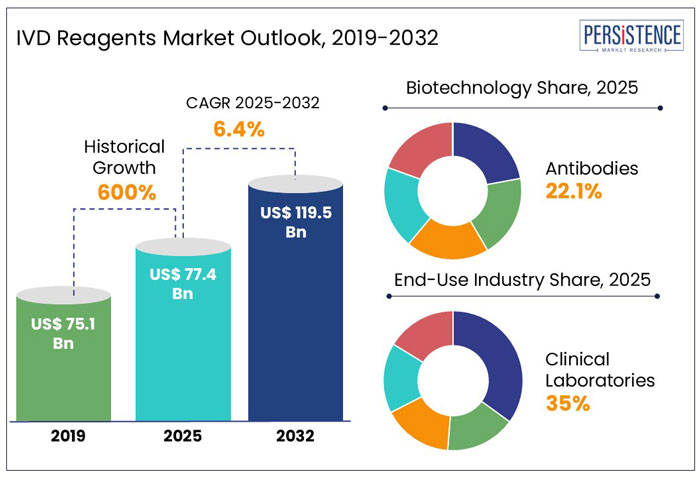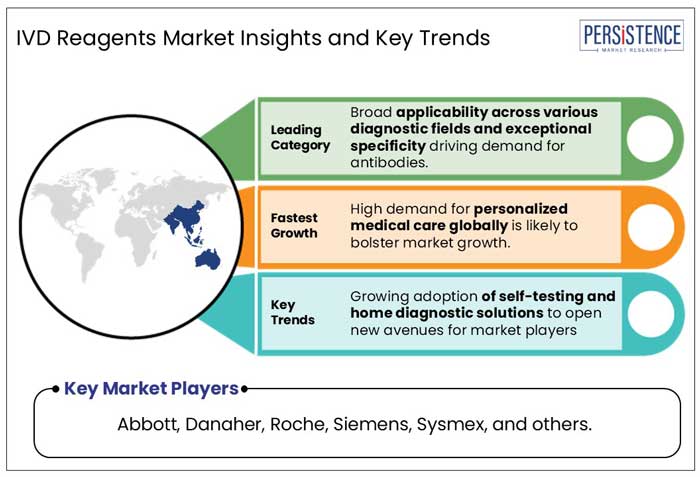Industry: Healthcare
Published Date: April-2025
Format: PPT*, PDF, EXCEL
Delivery Timelines: Contact Sales
Number of Pages: 182
Report ID: PMRREP35181
The global IVD reagents market size is estimated to reach US$ 77.4 Bn in 2025. It is likely to witness a CAGR of 6.4% from 2025 to 2032 and attain a value of US$ 119.5 Bn by 2032.
In vitro diagnostic (IVD) reagents are chemicals or substances used in diagnostic tests performed outside the body (in vitro) to detect, measure, or react with components of a sample, aiding in disease diagnosis, monitoring, and treatment.
According to Persistence Market Research, the market is highly competitive and healthcare companies like Abbott, Danaher Corporation, QIAGEN N.V., F. Hoffman-La Roche Ltd, Thermo Fisher Scientific Inc., and others are focusing on implementing growth strategies such as product launches, partnerships, collaborations, and facility expansion. For instance, in August 2024, Sysmex India, an in-vitro diagnostic (IVD) company in Mumbai, made significant investments to set up a new plant in Sanand, Ahmedabad, India. The company states that the new plant is expected to follow environmental regulations and will be equipped with state-of-the-art manufacturing capability.
Factors such as growing demand for personalized medicines and biomarker-based tests, booming biotech sector, technological innovations in molecular diagnostics, and increasing prevalence of chronic diseases globally are likely to surge adoption for IVD reagents through 2032.

Key Highlights of the Market
|
Global Market Attributes |
Key Insights |
|
IVD Reagents Market Size (2025E) |
US$ 77.4 Bn |
|
Market Value Forecast (2032F) |
US$ 119.5 Bn |
|
Projected Growth (CAGR 2025 to 2032) |
6.4% |
|
Historical Market Growth Rate (CAGR 2019 to 2024) |
6% |
Historical Period Witnessed Considerable Market Growth Fueled by Rising Healthcare Spending
During the historical period between 2019 to 2024, the global IVD reagents industry showcased a CAGR of 6%. The onset of the COVID-19 pandemic led to significant changes in the healthcare industry. As the pandemic spread, the demand for molecular diagnostics surged exponentially. As per studies, molecular diagnostic demand between March and October 2020 rose 20-fold.
Healthcare spending on IVD reagents increased dramatically, especially molecular diagnostics like RT-PCR, which became the ‘gold standard’ for COVID-19 diagnosis. For example, InBios received a US$ 12.7 Mn contract from the U.S. Department of Health and Human Services and the Department of Defense to increase production of rapid point-of-care COVID-19 tests, including antigen and antibody detection kits.
Growing Demand for Personalized Medical Care to Create New Growth Avenues
The global market for IVD reagents is anticipated to showcase a CAGR of 6.4% from 2025 to 2032. Personalized medicine is transforming healthcare by providing customized treatments that suit an individual's genetic profile, lifestyle, and environmental factors, with companion diagnostics playing a pivotal role. These tests identify biomarkers to determine patient eligibility for targeted therapies, ensuring treatments are both effective and safe while reducing trial-and-error approaches.
The future of diagnostics is driven by advancements in on-point-of-care testing (POCT) and automation. Companies are focusing on developing POCT-compatible reagents that help deliver lab-grade accuracy in decentralized settings, leveraging microfluidics and portable devices to provide accurate results across healthcare settings. For example,
In November 2024, Fapon, a leading life sciences company, showcased its innovative IVD total solutions at MEDICA 2024. The company highlighted its expertise in chemiluminescence immunoassay with the Shine i-series analyzers and over 70 reagent services. Fapon also introduced technology transfer and local manufacturing services to support global IVD manufacturers and enhance local diagnostic capabilities, ensuring high-quality raw materials meet European market demands for diseases like SCD, mpox, and H5N1.
Growing Preference for Automated Analyzers to Propel Market Growth
Automated analyzers are significantly contributing to the expansion of the IVD reagents market by enhancing efficiency and accuracy in diagnostic workflows. They automate multi-test sample analysis, increasing throughput and reducing turnaround times, which in turn boosts the demand for IVD reagents as they process high volumes of samples. The integration of automated analyzers with point-of-care testing systems further expands their reach beyond traditional laboratories, increasing the demand for specialized reagents.
Additionally, their adoption in emerging economies supports market growth by creating new opportunities for both automated analyzers and associated IVD reagents. Continuous technological advancements in these systems are further likely to drive innovation in reagent development, encouraging the adoption of advanced diagnostic tools and fueling market expansion during the forecast period.
Stringent Regulatory Requirements to Hinder Market Growth
The market for IVD reagents is heavily regulated to ensure safety, efficacy, and quality of diagnostic procedures. These regulations vary by country but generally involve a classification system based on risk levels. For instance, in China, IVD reagents are classified into three classes, with Class I being subject to filing and Classes II and III requiring registration with the National Medical Products Administration (NMPA). In the U.S., the FDA regulates IVDs as medical devices, requiring compliance with labeling requirements under 21 CFR 809 and submission of studies confirming their safety and effectiveness.
Similarly, in India, IVDs are regulated under the Medical Device Rules, 2017, by the Central Drugs Standard Control Organization (CDSCO), necessitating licenses for manufacturing, importing, and selling. Manufacturers need to adhere to the evolving regulations and standards to avoid non-compliance issues. Such regulations are likely to create problems for small and medium-sized enterprises due to their associated costs and complexity, leading to restricted market growth to a certain extent.
Adoption of Self-testing and Home Diagnostic Procedures to Open New Growth Prospects
High adoption of self-testing and home diagnostic procedures is anticipated to open new growth avenues for companies operating in the market for IVD reagents. This trend is driven by the increasing demand for delivering care closer to patients, which has been accelerated by the COVID-19 pandemic.
The expansion of point-of-care testing (POCT) reagents has significantly enhanced the availability of tests that can be conducted outside traditional laboratory settings. For instance, immunoassay-based POC testing analyzers offer high sensitivity and patient compliance, reducing the time needed to diagnose and manage diseases like HIV, malaria, and tuberculosis. As a result, POC testing products are becoming more widely used to support informed clinical decisions and improve healthcare outcomes.
The integration of advanced technologies such as AI and IoT is further expected to play an important role in enhancing diagnostic capabilities, presenting exciting growth opportunities for market players to strengthen their positions.
Antibodies Segment to Dominate with 22.1% Share; Wider Applicability in Diagnosis Procedures to Fuel Demand
Based on the type of reagents, the antibodies segment is expected to hold a share of about 23.5% in 2025. Antibodies are increasingly being used as IVD reagents due to exceptional specificity, sensitivity, and broad applicability across various diagnostic fields. Antibodies play a crucial role in immunoassays, molecular diagnostics, and point-of-care (POC) tests, enabling accurate illness identification.
Antibody-based assays such as Enzyme-Linked Immunosorbent Assay (ELISA), lateral flow assays, and chemiluminescence immunoassays are frequently used in the diagnosis of infectious diseases. Rapid antigen and serological testing became more and more necessary as a result of the COVID-19 pandemic, highlighting the role that antibodies play in point-of-care testing and extensive disease surveillance. Antibodies play a critical role in oncology by identifying tumor markers, including CA-125 (ovarian cancer), PSA (prostate cancer), and HER2 (breast cancer), allowing for early diagnosis and therapy effectiveness monitoring.
Clinical Laboratories Segment to Lead Drive by Enhanced Accuracy and Regulatory Compliance
Based on end use industry, the clinical laboratories segment is forecasted to hold about 35% of market share in 2025. Clinical labs are the preferred choice for highly accurate and validated diagnostic testing due to their advanced infrastructure, stringent quality control measures, and expertise in handling complex tests.
One of the fundamental benefits of clinical laboratories is their capacity to perform high-throughput testing, processing huge numbers of samples efficiently while adhering to regulatory standards. This establishes them as the gold standard for confirmatory testing, particularly in crucial areas such as oncology, infectious diseases, and autoimmune diagnostics.

Presence of Well-Established Healthcare Infrastructure to Boost Product Adoption
North America is anticipated to dominate the market for IVD reagents with a share of about 38.7% in 2025. The region’s strong healthcare infrastructure and ongoing investments in diagnostic technologies are factors supporting the growth of the market during the forecast period.
According to the American Hospital Association (AHA), as of 2025, there are 6,093 registered hospitals and 913,136 beds in the U.S. The presence of well-established healthcare infrastructure significantly boosts the demand for IVD reagents by enhancing diagnostic capabilities, increasing accessibility to care, and ensuring regulatory compliance. In addition, robust healthcare systems often receive government support and funding, leading to increasing investments in cutting-edge technologies such as point-of-care testing (POCT) and digital diagnostics. For example,
Presence of Prominent IVD Reagents Companies in China, India, and Singapore to Bolster Market Growth
The global market for IVD reagents in Asia Pacific is projected to witness substantial growth in the forthcoming years. The growth is attributable to the presence of established in vitro diagnostic (IVD) companies such as Sysmex Corporation, Fujifilm, Eiken Chemical Co. Ltd, Hangzhou AllTest Biotech Co., Ltd, Shimadzu Corporation, and others. These companies are contributing to the growth of the market by expanding their market presence through strategic partnerships and investments in research and development activities. For instance,
Eiken Chemical has been adopting its Loop-mediated Isothermal Amplification (LAMP) technology for rapid genetic testing. This technology is used for detecting diseases like tuberculosis, malaria, and COVID-19. The company continues to focus on research and development activities, with about 150 staff dedicated to developing new technologies and products.
Stringent Government Regulations for Diagnostic Procedures in Europe to Boost Product Demand
The market for IVD reagents in Europe is likely to register significant growth in the forthcoming years. Factors such as presence of stringent regulatory compliance, increasing adoption of molecular diagnostic testing in personalized medicine, and expansion of testing capabilities in clinical laboratories are projected to drive market growth between 2025 and 2032. The implementation of the In Vitro Diagnostic Regulation (IVDR) in Europe has established stringent requirement for diagnostic products prompting major companies such as Roche Diagnostics, Abbott Laboratories, Thermo Fischer Scientific, and other to invest in research and development to meet the diagnostic standards.
The global market for IVD reagents driven by ongoing developments in automation, immunoassays, and molecular diagnostics. Businesses are making significant investments in next-generation sequencing (NGS) technologies, point-of-care (POC) solutions, and AI-powered platforms. Strategic collaborations, mergers, and acquisitions are common as industry players seek to expand their product offerings and geographic reach. Additionally, companies are focusing on gaining a stronghold in the market by manufacturing quick, easy-to-use diagnostic reagents on account of rapid growth in telemedicine vertical of healthcare industry. .
|
Report Attributes |
Details |
|
Historical Data/Actuals |
2019 - 2024 |
|
Forecast Period |
2025 - 2032 |
|
Market Analysis Units |
Value: US$ Bn/Mn, Volume: As applicable |
|
Geographical Coverage |
|
|
Segmental Coverage |
|
|
Competitive Analysis |
|
|
Report Highlights |
|
|
Customization and Pricing |
Available upon request |
By Type of Reagent
By Technology
By Application
By End-Use Industry
By Region
To know more about delivery timeline for this report Contact Sales

The IVD Reagents market size is US$ 77.4 Bn in 2025.
The industry will likely be valued at US$ 119.5 Bn in 2032.
A few of the leading players in the market are Abbott, Beacon, Thermo Fisher Scientific, Danaher, and Siemens.
The industry is estimated to rise at a CAGR of 6.4% through 2032.
North America is projected to hold the largest share of the industry in 2025 as well as through the forecast period.